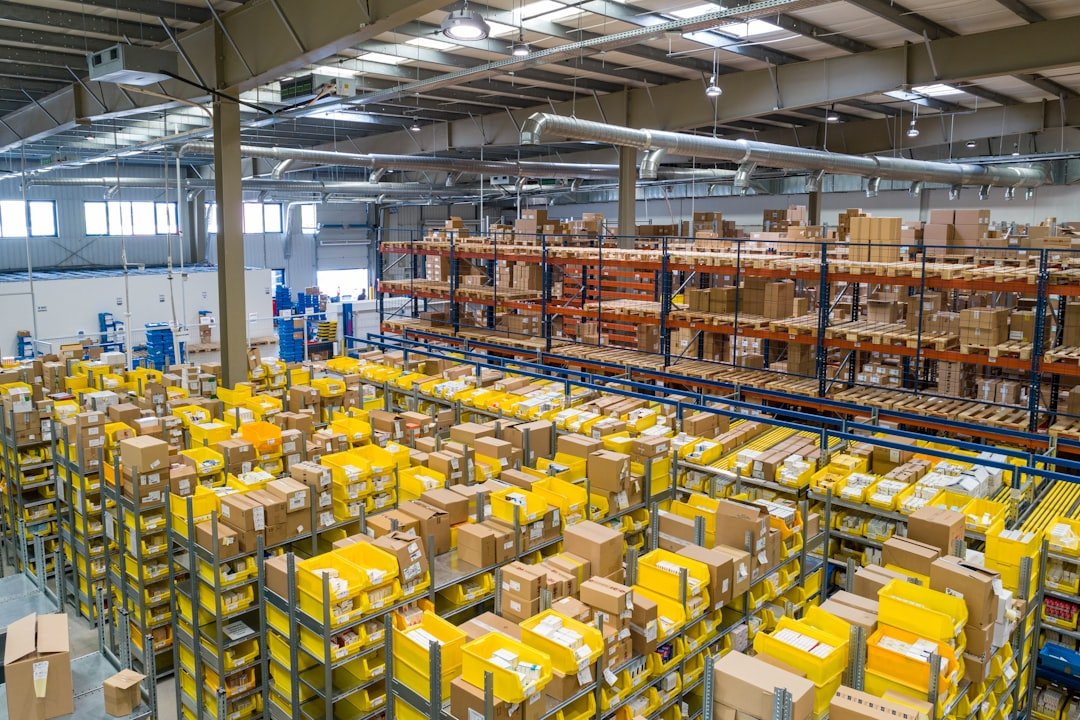Amazon FBA: Learn How to Start Your FBA Business Fast

Amazon FBA, or Fulfillment by Amazon, is a service provided by the e-commerce giant that allows sellers to store their products in Amazon’s fulfillment centers. Once an order is placed, Amazon takes care of the picking, packing, and shipping of the products to the customers. This means that sellers can focus on sourcing and marketing their products, while Amazon handles the logistics and customer service.
The process of using Amazon FBA is relatively straightforward. Sellers send their products to Amazon’s fulfillment centers, where they are stored until they are sold. When a customer places an order, Amazon picks the product from its warehouse, packs it, and ships it to the customer. Amazon also handles returns and customer service for FBA orders. In addition to these services, Amazon FBA also offers Prime shipping benefits to customers, which can help increase sales for FBA sellers. Overall, Amazon FBA provides sellers with a convenient and efficient way to reach millions of customers and fulfill orders without having to manage the logistics themselves.
Setting Up Your Amazon FBA Account: Step-by-Step Guide
Setting up an Amazon FBA account is a relatively simple process that can be completed in a few easy steps. First, you’ll need to create an Amazon seller account if you don’t already have one. Once you have a seller account, you can enroll in the FBA program by navigating to the “Fulfillment by Amazon” section in your seller account settings. From there, you can create a new FBA shipment by adding the products you want to sell through FBA and specifying the quantity of each product you are sending to Amazon’s fulfillment centers. After creating your shipment, you’ll need to prepare your products for shipping according to Amazon’s guidelines and then print and apply the shipping labels provided by Amazon.
Once your products have been shipped to Amazon’s fulfillment centers, you can monitor their status and track their inventory levels through your seller account. When a customer places an order for one of your FBA products, Amazon will handle the picking, packing, and shipping of the product, as well as any customer service inquiries or returns. As an FBA seller, you’ll also have access to tools and reports to help you manage your inventory and sales performance. Overall, setting up your Amazon FBA account is a relatively straightforward process that can be completed in just a few simple steps.
Sourcing Products for Your FBA Business: Tips and Strategies
Sourcing products for your Amazon FBA business is a crucial step in building a successful e-commerce operation. There are several strategies and tips that can help you find profitable products to sell through FBOne popular approach is to look for products with high demand and low competition, as this can help you maximize your sales potential. You can use tools like Jungle Scout or Helium 10 to research product niches and identify opportunities with high demand and low competition.
Another strategy for sourcing products for your FBA business is to look for unique or differentiated products that can stand out from the competition. This could involve creating your own private label products or finding suppliers that offer exclusive or custom products. By offering unique products that are not readily available from other sellers, you can differentiate your business and attract customers looking for something special.
In addition to these strategies, it’s important to consider factors like product size and weight, as well as potential profit margins when sourcing products for your FBA business. Products that are small and lightweight are often more cost-effective to store and ship through FBA, while products with high profit margins can help you maximize your return on investment. By carefully considering these factors and using strategic sourcing tactics, you can find profitable products to sell through Amazon FBA.
Optimizing Your Product Listings for Maximum Visibility
Optimizing your product listings is essential for maximizing visibility and sales on Amazon. There are several key elements to consider when optimizing your product listings, including keywords, images, and product descriptions. One of the most important aspects of optimizing your product listings is using relevant keywords in your titles, bullet points, and product descriptions. By including keywords that are relevant to your products and target audience, you can improve your chances of appearing in search results and attracting potential customers.
In addition to using keywords, it’s important to use high-quality images that showcase your products in the best possible light. Clear, professional images can help attract customers and encourage them to click on your listings. You should also use high-quality product descriptions that provide detailed information about your products and highlight their key features and benefits. By providing comprehensive product information, you can help customers make informed purchasing decisions and reduce the likelihood of returns or negative reviews.
Another important aspect of optimizing your product listings is managing customer reviews and feedback. Positive reviews can help build trust and credibility for your products, while negative reviews can have a detrimental impact on sales. By actively managing customer feedback and addressing any issues or concerns promptly, you can improve your product ratings and increase customer confidence in your offerings. Overall, optimizing your product listings is essential for maximizing visibility and sales on Amazon FBA.
Utilizing Influencer Marketing to Boost Your FBA Sales
Influencer marketing can be a powerful strategy for boosting sales and increasing brand awareness for your Amazon FBA business. By partnering with influencers who have a large and engaged following, you can reach new audiences and leverage their influence to promote your products. There are several ways to utilize influencer marketing for your FBA business, including sponsored content, product reviews, and affiliate partnerships.
One effective approach is to collaborate with influencers to create sponsored content that showcases your products in an authentic and engaging way. This could involve sponsored posts on social media platforms like Instagram or YouTube, where influencers can demonstrate or review your products for their followers. By partnering with influencers who align with your brand and target audience, you can leverage their credibility and reach to promote your products effectively.
Another strategy for utilizing influencer marketing is to establish affiliate partnerships with influencers who can promote your products to their audience in exchange for a commission on sales. This can be a cost-effective way to drive sales and increase brand exposure, as you only pay for performance based on the influencer’s ability to generate sales. By providing influencers with unique tracking links or discount codes, you can track the effectiveness of their promotions and reward them based on their performance.
Overall, influencer marketing can be a valuable strategy for boosting sales and increasing brand visibility for your Amazon FBA business. By partnering with influencers who have a strong connection with your target audience, you can leverage their influence to promote your products effectively and drive sales.
Managing Inventory and Fulfillment with Amazon FBA
Managing inventory and fulfillment is a critical aspect of running a successful Amazon FBA business. With the help of Amazon’s fulfillment centers, sellers can store their products in multiple locations across the country, which allows for faster shipping times and lower shipping costs. However, it’s important to monitor inventory levels closely and ensure that you have enough stock available to fulfill customer orders.
Amazon provides tools and reports to help sellers manage their inventory levels and forecast demand for their products. By using these tools effectively, sellers can avoid stockouts and ensure that they have enough inventory on hand to meet customer demand. It’s also important to monitor sales trends and adjust inventory levels accordingly, especially during peak seasons or promotional periods.
In addition to managing inventory levels, sellers also need to consider fulfillment costs and fees associated with using Amazon FBBy understanding the costs involved in storing and fulfilling their products through FBA, sellers can make informed decisions about pricing and profitability. It’s important to factor in fulfillment fees, storage fees, and other expenses when calculating the overall cost of using Amazon FBA.
Overall, managing inventory and fulfillment with Amazon FBA requires careful planning and monitoring of inventory levels, as well as an understanding of the costs involved in using the service. By leveraging Amazon’s tools and reports effectively, sellers can optimize their inventory management processes and ensure that they have enough stock available to fulfill customer orders while maintaining profitability.
Scaling Your FBA Business for Long-Term Success

Scaling an Amazon FBA business for long-term success involves expanding product offerings, optimizing operations, and diversifying sales channels. One key strategy for scaling an FBA business is to expand product offerings by adding new products or variations of existing products. By continuously introducing new products that align with market trends and customer demand, sellers can increase their sales potential and reach new customer segments.
Another important aspect of scaling an FBA business is optimizing operations to improve efficiency and reduce costs. This could involve streamlining inventory management processes, optimizing product listings for maximum visibility, or implementing automation tools to streamline order fulfillment. By continuously improving operational efficiency, sellers can scale their businesses effectively while maintaining profitability.
Diversifying sales channels is another key strategy for scaling an FBA business for long-term success. In addition to selling on Amazon’s marketplace, sellers can explore other e-commerce platforms or even create their own online store to reach new customers and reduce reliance on a single sales channel. By diversifying sales channels, sellers can mitigate risk and expand their reach in the e-commerce market.
Overall, scaling an Amazon FBA business for long-term success requires a strategic approach that involves expanding product offerings, optimizing operations, and diversifying sales channels. By continuously innovating and adapting to market trends, sellers can position their businesses for sustainable growth and long-term success in the e-commerce industry.
If you’re interested in learning more about starting your own FBA business, you should check out this article on howtostart.digital. This website offers valuable insights and tips on how to get your FBA business up and running quickly and efficiently. Whether you’re a beginner or an experienced entrepreneur, you’ll find helpful information to guide you through the process of launching your own successful FBA business.
FAQs
What is Amazon FBA?
Amazon FBA stands for Fulfillment by Amazon. It is a service provided by Amazon that allows sellers to store their products in Amazon’s fulfillment centers. Amazon then picks, packs, ships, and provides customer service for these products.
How does Amazon FBA work?
Sellers send their products to Amazon’s fulfillment centers, and Amazon takes care of the storage, shipping, and customer service. When a customer places an order, Amazon picks the product from its warehouse and ships it to the customer.
What are the benefits of using Amazon FBA?
Some benefits of using Amazon FBA include access to Amazon’s vast customer base, Prime shipping eligibility, and the ability to outsource storage and shipping logistics to Amazon.
How do I start an Amazon FBA business?
To start an Amazon FBA business, you will need to create an Amazon seller account, find products to sell, source those products, and then send them to Amazon’s fulfillment centers. You will also need to optimize your product listings and manage your inventory.
What are the costs associated with Amazon FBA?
There are several costs associated with Amazon FBA, including storage fees, fulfillment fees, and referral fees. Additionally, there may be costs associated with sourcing products, shipping them to Amazon, and advertising your products on the platform.
What are some tips for success with Amazon FBA?
Some tips for success with Amazon FBA include conducting thorough product research, optimizing your product listings for search, and providing excellent customer service. It’s also important to stay on top of inventory management and to continually monitor and adjust your pricing and advertising strategies.





